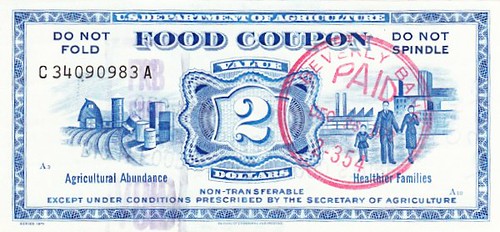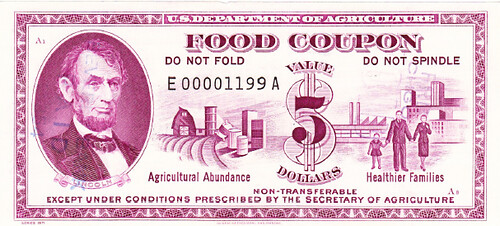
PREV ARTICLE
NEXT ARTICLE
FULL ISSUE
PREV FULL ISSUE
FOOD STAMPS AS MONEYTom DeLorey writes:
The drivers hated them because they were always new, and tended to stick together just like regular new currency does. Also, they had to rubber stamp each one with a deposit stamp. As I had to count them again from all 42 drivers I hated them all the more, but recognize them as being a part of the American numismatic realm.
David Gladfelter forwarded a copy of an article he wrote for a local newsletter when New Jersey switched from food stamp coupons to EBT cards. Here are some excerpts. Thanks!
-Editor
The Food Stamp program is a joint Federal-State program to improve nutritional standards for America's low-income families and individuals. It began in 1961 with pilot programs in seven rural areas and one city, Detroit, based on the experience of the 1939-1943 surplus food distribution plan of the Federal Surplus Commodities Corporation and its successor agencies. The success of the pilot programs in improving the quality and quantity of the participants' diets and in expanding markets for livestock products, fruits and vegetables led to passage of the Food Stamp Act (Public Law 88-525) which was signed into law on August 31, 1964. Today, the program operates nationwide. Eligible households participate in the program by purchasing an allotment of food stamps. The amount they pay (ranging from zero to a maximum of 30% of their net monthly income) is based on income and family size. Initially, the households received books of paper coupons in various denominations, which they redeemed at participating food stores for authorized food purchases. The food stores deposited the collected coupons in their bank accounts for credit, endorsing them on back. The banks handled the coupons like checks, clearing them through the various Federal Reserve banks. More recently, the food stamp benefits have been provided to participants by "paperless" electronic benefits transfer (EBT) cards, which are used like debit cards, the merchant deducting the amount of the purchase directly from the participant's food stamp account. The Food Stamp program had an exonumic side. Until January 1, 1979, retail grocers gave change for the coupons in paper scrip or plastic tokens. Thereafter, merchants were required to make change in U. S. coins, and the food stamp change tokens and scrip went out of use. Collectors beat the bushes to find and assemble sets of the tokens and scrip before they disappeared altogether. A leader in this field of exonumia was Jerry F. Schimmel, of San Francisco, who published the Food Stamp Change Newsletter from 1980 to 1984. It circulated to a coterie of a few hundred exonumists. Our editor, Gary Patterson, published listings of New Jersey's food stamp tokens in Schimmel's newsletter and in the TAMS Journal.


Shown here are two canceled food stamp coupons of the "series 1971" with the imprint of the Bureau of Engraving and Printing.
To read the earlier E-Sylum article, see:
SMITHSONIAN ACQUIRES USDA FOOD STAMP ARCHIVE
(www.coinbooks.org/esylum_v13n04a14.html)
The Numismatic Bibliomania Society is a non-profit organization promoting numismatic literature. See our web site at coinbooks.org. To submit items for publication in The E-Sylum, write to the Editor at this address: whomren@gmail.com To subscribe go to: https://my.binhost.com/lists/listinfo/esylum All Rights Reserved. NBS Home Page Contact the NBS webmaster 
|
